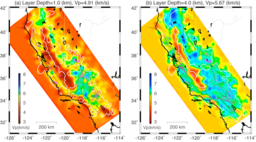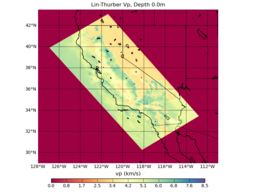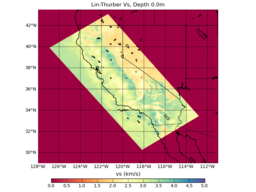Lin Thurber CVM
Contents
Overview
The Lin Thurber et al (2010) CVM is a seismic velocity model of the California crust and uppermost mantle using a regional-scale double-difference tomography algorithm. The details are described in Lin et al. (2010).

Model Description
Digital Elevation Model
Vp Model
The Vp model is a 1320km x 600km grid with spacing of 10.0km. The model is published as a space-delimited text file, available from Vp Model.
Vs Model
The Vp model is a 1320km x 600km grid with spacing of 30.0km. The model is published as a space-delimited text file, available from Vs Model.
Density Model
The original model does not provide density values. We adopt the Nafe-Drake scaling relationship to compute density from Vp (Ludwig et al., 1970; Brocher , 2005):
rho = 1.6612*Vp - 0.4721*(Vp)^2 + 0.0671*(Vp)^3 - 0.0043*(Vp)^4 + 0.000106*(Vp)^5,
Images
These preliminary maps are based on querying the model at an elevation offset of -1000.0m from MSL. We will need to add a DEM to UCVM in order to properly query this model by depth. The model is referenced using inverse bilinear interpolation of the original model boundaries.
As seen in the plots, the Vp model is higher resolution (~10km) than the Vs Model (~30km).
Original Model Format
Recently, we determined the seismic velocity model of the California crust and uppermost mantle using a regional-scale double-difference tomography algorithm. Our model is the first 3D seismic velocity model for the entire state of California based on local and regional arrival time data that has ever been developed. It has improved areal coverage compared to the previous northern and southern California models, and extends to greater depth due to the inclusion of substantial data at large epicentral distances.
Recently, we have configured a program so that this Lin model can be queried through the UCVM API. the original model format is a table of data values in the following format.
FILE FORMAT DESCRIPTION -117.7230 37.8242 1.00 250.00 0.00 5.0390 109.13 lon lat dep x y vp DWS (derivative weight sum)
References
- Brocher, T. M. (2005), Empirical relations between elastic wavespeeds and density in the Earth's crust, Bull. Seis. Soc. Am., 95 (6), 2081-2092.
- Lin, G., C. H. Thurber, H. Zhang, E. Hauksson, P. Shearer, F. Waldhauser, T. M. Brocher, and J. Hardebeck (2010), A California statewide three-dimensional seismic velocity model from both absolute and differential Times, Bull. Seism. Soc. Am., 100, in press.
- Ludwig, W. J., J. E. Nafe, and C. L. Drake (1970), Seismic refraction, in New Concepts of Sea Floor Evolution, The Sea: Ideas and Observations on Progress in the Study of the Seas, vol. 4, edited by A. E. Maxwell, pp. 53-84, Wiley-Interscience, New York.

